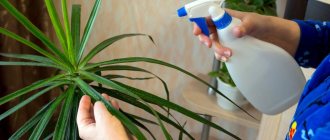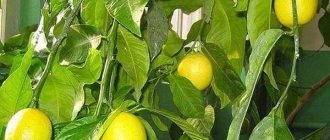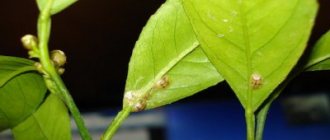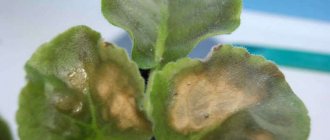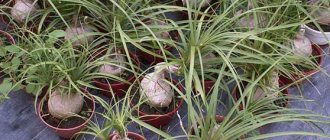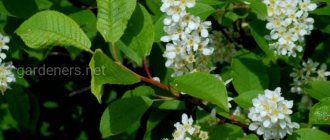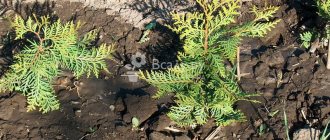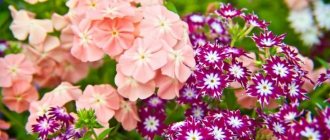Homemade lemon diseases - causes and treatment
Before you begin treating indoor lemon diseases, you need to find out the reason why they appeared. It is important not only to engage in treatment, but also to immediately eliminate the factors that triggered the development of the disease.
Indoor lemon
Why do lemon leaves turn yellow?
Having decided to grow lemons at home, you need to be prepared for the fact that the tree will often get sick if you do not create ideal conditions for it. Homemade lemon diseases, causes and treatment are always interrelated factors.
Causes of disease development:
- Incorrect growing conditions (watering, lack or excess of sunlight, indoor humidity and other factors).
- Errors were made during boarding or transfer.
- The soil or container was contaminated before planting.
- The appearance of pests at home and on other indoor plants.
- Fungal spores, viruses and bacteria can enter the house during ventilation.
Often the cause is a lack of nutrients in the soil.
Lemon leaf chlorosis
Leaf chlorosis is one of the common diseases that develops due to improper watering, lack of iron and nitrogen in the soil and increased soil acidity.
Leaf chlorosis
Symptoms of this indoor lemon disease:
- The leaves acquire a yellow tint and bloom deformed.
- The leaves begin to fall abundantly.
- The top is drying out.
- The roots begin to die.
Treatment consists of applying root and foliar fertilizers.
Additional Information! To saturate the soil with iron, water the soil with copper sulfate.
Feedings with the following components are also effective:
- antichlorosis;
- iron chelate;
- ferrylene;
- ferovit.
Fertilizers are applied according to the instructions indicated on the packaging.
Why do lemon leaves curl?
Causes of leaf curling:
- sooty fungus;
- gommosis;
- lack of nutrients;
- aphid;
- thrips.
Spraying with garlic broth, wiping the leaf plate with soapy water and a warm shower helps against aphids and thrips. Chemical treatments are effective.
Also, the leaves curl due to a deficiency of copper and calcium in the soil. Fertilizing is applied several times a month. In the warm season, their number increases.
With sooty fungus, the leaves not only curl, but also have a black coating on them. In order to cure the plant, the foliage must be wiped with a damp cloth and then sprayed with Fitosporin-M.
Lemon leaves curl
Another disease is gommosis. Signs of the disease include the release of yellow resin from cracks in the bark, the death of the bark and the appearance of longitudinal spots on the leaves. All affected areas are cut off. The cut areas are sprinkled with wood ash, or treated with copper sulfate and lubricated with garden varnish.
Washing the tonsils.
The procedure for washing the tonsils has a great positive effect, as a result of which pus is released from the lacunae and the medicine is administered. There are several ways to carry out the procedure.
The oldest, so to speak, ancient method is sanitation with a syringe. It is used quite rarely due to its low efficiency and traumatic nature, compared to the advent of more modern methods. The syringe is used when the patient has a strong gag reflex or very loose tonsils.
In other cases, a more effective method is used - vacuum rinsing with a special attachment of the Tonzillor apparatus.
But it is not without its drawbacks:
- the container into which the purulent contents of the tonsils are “pumped out” is opaque, and the doctor cannot see whether the rinsing is complete;
- The design feature of the nozzle is such that when the pressure necessary for complete rinsing is reached, the nozzle can injure the tonsils.
Our clinic for the treatment of tonsillitis offers its patients an alternative painless option for washing the tonsils using the improved “Tonsillor” nozzle - this is the “know-how” of our clinic. There are no analogues of our nozzle in other medical institutions in Moscow. It eliminates the disadvantages of a conventional nozzle: the rinsing container, which is suctioned to the tonsil, has transparent walls, and the otorhinolaryngologist can see what “comes out” of the tonsils. This eliminates unnecessary manipulations. The nozzle itself is non-traumatic and can be used even by children of school age.
Lemon leaves are falling - what to do?
If your lemongrass leaves begin to fall, you don’t need to panic right away. This can happen for completely natural reasons. Any plant changes its leaf cover, and citrus fruits are no exception.
Kalanchoe diseases - causes and treatment
Reasons why a lemon drops its leaves:
- lack of sunlight;
- improper watering (both excess and lack of moisture have a negative effect);
- low or too high room temperature;
- lack of nutrients in the soil;
- Malsecco's disease and gommosis.
The reasons why a lemon drops its leaves and what to do in this case depend on how often and in what quantity it falls. If this is a mass phenomenon, then we need to find out why this is happening.
Although lemon is native to hot tropical countries, direct sunlight is harmful to the plant. It is better to place the pots in a place where there will be diffused light.
Attention! In autumn and winter, citrus may lack sunlight. Because of this, it can shed leaves. Starting from October, you need to turn on lamps with additional lighting in the evenings for several hours.
The soil needs to be watered as soon as the top layer dries out. If you fill the soil, it will become dense and oxygen and nutrients will not reach the roots. This leads to the death of the roots.
The optimal temperature at which citrus will feel comfortable is +18-+20 degrees. In the warm season, if possible, the pot can be taken outside or onto the balcony.
In addition to improper care, lemons can lose their leaves due to disease. With Malsecco disease, the leaf blade first turns red-orange and then dies. In this case, the petioles remain on the branches. It develops mainly in spring or autumn. There is no cure for Malsecco.
Pest characteristics
Mealybugs (Pseudococcidae) are small insects from the family Hemiptera. Their sizes in different species can vary from 0.5 to 12 mm; parasitic scale insects are mainly 3-6 mm in length. These parasites are clearly visible to the naked eye. Their body is covered with a white powdery coating that resembles flour, which is why the parasite is called “mealy.” This helps them avoid moisture loss. Scale insects are colonial insects that live in groups. Clusters of scale insects look like dirty cotton wool glued to the leaves. These pests live in the axils of the leaves, between the stems, and under the bark.
The white waxy coating helps the mealybug retain moisture
Larvae and adult females feed on juices from the leaves, shoots and buds of the plant, which they suck out with their long proboscis. Adult males do not feed, since they do not have mouthparts. Often at the posterior end of the insect's body or along the entire edge there are waxy plates of varying lengths.
In mealybugs, males and females differ. Males are more like small flies or mosquitoes: they have wings, legs are normally developed, there are two tail filaments on the abdomen, but no mouthparts.
In some species of scale insects, legs are reduced (that is, absent). Scale insects reproduce by eggs, but there are also viviparous species. These insects are very prolific; they can produce two, and some even four, generations in a year.
The reverse surface of the leaf on which the mealbug has settled
Mealybugs have one very unpleasant feature. When unfavorable conditions occur, these insects can go into a dormant state. And when environmental conditions improve, the scale insects become active again and begin to actively feed and reproduce again.
Sticky coating on lemon leaves
Gooseberry diseases and their treatment
Sticky plaque is not always a sign of disease or a pest. It is quite possible that plaque is released due to improper watering. In the natural environment, a sticky coating appears to attract ants, which in turn destroy pests on the tree. If a sticky coating appears on your homemade citrus fruits, don’t panic right away.
Pests of indoor lemons that cause a sticky coating:
- scale insect;
- aphid.
The scale insect is dangerous because if it is not noticed in time, the citrus will die. If a sticky coating appears on the tree, the plant begins to dry out, and spots appear on the foliage and stems, then it is a scale insect. Treatment with Fitoverm and Aktara helps against the pest. To completely destroy the pest, 3-4 treatments will be required at intervals of 2 weeks.
Aphids on citrus
The second cause of sticky plaque is aphids. Detecting a pest is not at all difficult. These are small green bugs that can be seen both on the foliage and on the rest of the plant. To destroy the pest, citrus is sprayed with a solution of laundry soap every day for a week. You can also use garlic water. You need to spray every day for 5 days.
Signs of the phenomenon
The leaves of a healthy lemon are clean, elastic, smooth, and richly green. Unhealthy spotting manifests itself in different ways, depending on the cause that caused it. The following changes should alert you :
- The leaf plates are covered with spots that do not have clear boundaries - stains. Some have a pronounced yellow color, others are barely noticeable.
- Almost all foliage suddenly and quickly turns yellow, loses its elasticity and smoothness.
- An edge burn is observed - the edge turns yellow and dries, the leaves fall off.
- The spots look like small specks that merge over time. A completely yellowed leaf falls off.
- Round spots with clear contours appear on parts of the leaf apparatus. The number of spots either increases or decreases noticeably. Symptoms are observed for a long time, the plant gradually withers.
- Round spots appear not only on the leaves, but also on all parts of the tree.
Having discovered problem leaves on an indoor lemon, it is necessary to analyze the characteristics of the damage and the conditions under which the plant is kept. Based on this data, we can draw conclusions about why yellow and brown spots appeared on the crop and what to do to get rid of them.
Read more about the yellowing of lemon leaves in this article, and you can find out what to do if a lemon’s leaves have fallen off here.
Yellow spots on lemon leaves - what to do
Yellow spots are a common symptom of most diseases. In order to accurately determine the cause of their appearance, you need to pay attention to other signs.
Anthurium has brown spots on the leaves - causes and treatment
Why do indoor lemon leaves turn yellow?
- hypothermia;
- lack of magnesium or zinc;
- fungal, bacterial and viral diseases (cancer, root rot);
- appearance of insects.
Yellow spots appear due to scale insects. The fight against this pest has been described in another section.
The second factor is hypothermia. Lemon is a very heat-loving plant and a sharp drop in temperature never goes away without leaving a trace. If the temperature in the room drops below +14 degrees, you need to either turn on the heater or move the citrus to a warmer place.
Important! Lemon does not tolerate frequent moving of the pot. The tree may even die from this.
You can determine which mineral the citrus plant lacks by the location of the spots. If the tips dry out, it means there is a deficiency of magnesium in the soil. If yellow spots appear near the veins, there is not enough zinc in the soil.
Scab on lemon
Diseases that cause yellow spots:
- Cancer. An incurable disease that causes dark brown spots with a yellow border. In this case, the plant should be thrown out immediately so that other crops do not get cancer.
- Root rot. You need to cut off all affected areas, then transplant the citrus into another pot with new soil. After this, add mineral fertilizers.
- Scab. Small pink-yellow or brown warts appear on the underside of the leaf. The affected areas of the lemon are cut off. The plant itself is sprayed with copper oxychloride or copper sulfate.
Symptoms of tonsillitis.
A symptom that combines both types is pain in the throat. The pain can be both severe and tolerable. The patient experiences severe discomfort while eating and swallowing.
Sore throat is much more severe than a chronic disease and is accompanied by the following symptoms:
- increased body temperature (up to 40°C);
- very severe sore throat;
- enlarged lymph nodes;
- accumulations of pus on the tonsils (plaque, pustules);
- enlarged tonsils;
- headache;
- weakness.
The symptoms and treatment of chronic tonsillitis are somewhat different from the manifestations of tonsillitis. With a chronic disease, the temperature remains at 37°C. A sore throat, cough, and bad breath are added. There is a white coating on the tonsils. The symptoms are less pronounced, since the course of the disease itself is characterized by remissions and exacerbations. A patient suffering from a chronic form of the disease loses his ability to work, gets tired quickly, and loses his appetite. Often a person suffers from insomnia.
The tips of the lemon leaves dry out
Description of the reasons why leaf tips dry out:
- dry air;
- low or high room temperature;
- using tap water for irrigation;
- too dense soil in the pot;
- waterlogged or overdried soil.
If the end of the leaf dries out due to dry air, then you need to increase the humidity in the room. You can place a cup with wet expanded clay next to the citrus tree, regularly spray the tree and wipe the leaves, or buy an air humidifier for your home.
Note! Drying of the tips is also accompanied by yellowing of the foliage.
It is not recommended to use tap water for irrigation. It contains a large amount of fluorine and chlorine, so it is too hard. It is better to use purchased and rain water or melted snow. You can also boil and then settle tap water. Before watering, add a few drops of lemon juice or a little citric acid to soften it.
If the soil in the pot is compacted, you need to replant. In order for the lemon to grow normally, transplants are carried out once every 2 years. If necessary, lemon can be replanted every year. Regular transplants will help revive the citrus.
Also, the edges may dry out due to improper watering and temperature disturbances. In summer, the soil should not be over-moistened, and in winter, it should not be allowed to dry out.
How it is used in health care
Due to its properties, lemon is quite successfully used in cosmetology as a means to cleanse and lighten the skin. It is also rightfully considered one of the best bactericidal agents, as it destroys about 12 types of different bacteria. A drink made from lemon removes toxins from the body, restores digestion processes and relieves headaches. It is good as a diuretic; it is used to treat the throat and respiratory tract.
sour but healthy fruit
Since ancient times, folk medicine in different countries has kept various recipes for using lemon to cure malaria, dropsy, scurvy, jaundice, hemorrhoids, pulmonary tuberculosis, gout and other diseases. Most often, it is recommended to drink diluted lemon juice, diluting it with hot water 1:2. In this form, it helps with gastrointestinal diseases, fever, urolithiasis, hemorrhoids, atherosclerosis and metabolic disorders, if you drink it 2 or 3 times a day.
In ancient times, Avicenna advised women to eat lemons during pregnancy, because in this way they could cope with toxicosis.
How to use lemon so that it is tasty and healthy?
In cooking, it is useful to season vegetable salads with lemon juice; There is no need to add salt to them. As flavoring additives, the fruit or lemon zest is added to various culinary products and desserts. The strong aroma of citrus is used in aromatherapy; it tones, improves mood and gives vigor to a person. Essential oil is used to disinfect and freshen indoor air.
Losing weight with lemon is a pleasure, and it can only cause harm if you overeat it. It reduces the desire to snack frequently if you eat a little of it. Ayurveda claims that if you eat only one lemon a day, good health is ensured.
White spots on lemon leaves
The reason why white spots appear on lemon leaves is powdery mildew. It is not difficult to treat this disease if it is detected at an early stage. The disease can affect both old and young lemons.
Powdery mildew
As the fungal disease progresses, symptoms change. First, the leaves acquire a yellow tint and curl, then a white coating appears. The plant stops developing. New shoots do not appear, old foliage falls off. In order to prevent the development of the disease, lemons are regularly taken out into the fresh air in the summer, and in the winter the room is ventilated several times a week.
If powdery mildew does appear, you need to start treatment immediately. Affected leaves are immediately cut off and thrown away. The rest of the plant is sprayed with fungicides (for example, Skor or Horus). Treatment with copper sulfate is also effective.
Dangerous symptoms
In some people, high blood pressure is asymptomatic, but in most cases the following symptoms are observed:
- weakness and fatigue,
- pressing or throbbing headache in the occipital and/or temporal part,
- nausea,
- dizziness,
- chest pain,
- noise in ears,
- shortness of breath during habitual physical activity,
- numbness of the limbs,
- blurred vision, flashing spots before the eyes,
- irritability,
- increased sensitivity to light (sometimes to sounds).
The appearance of even one or two of the symptoms listed above should be a cause for concern. Some people prefer to simply “endure” an episode of high blood pressure “so as not to be poisoned by all this chemistry” (that is, pills). But such manifestations cannot be ignored, since, as we said above, high blood pressure is fraught with a number of dangerous consequences.
Why doesn't lemon bear fruit?
Reasons why lemon does not bear fruit:
- Incorrect vaccination. If the plant was grown from a seed, it will never bear fruit. You can graft lemon onto other varieties of lemons, oranges or grapefruits.
- Temperature violations. If the grafting was carried out successfully and the tree bloomed, and then all the inflorescences fell off, then the problem is in the air temperature. The most favorable temperature is 23-25 degrees.
- Low humidity levels. The humidity level in the room should be 70-80%.
- A large number of inflorescences. If there are a lot of inflorescences on a tree, they take a lot of energy from it and as a result, not a single flower produces fruit. You need to immediately pick off small flowers.
- Lack of nutrients in the soil. As soon as the lemon begins to bloom, fertilizers for citrus plants are added to the soil.
Important! In order for a lemon to bloom, it needs conditions similar to those in its homeland in tropical forests: high humidity, a lot of diffused sunlight and regular fertilizing with complex mineral fertilizers.
